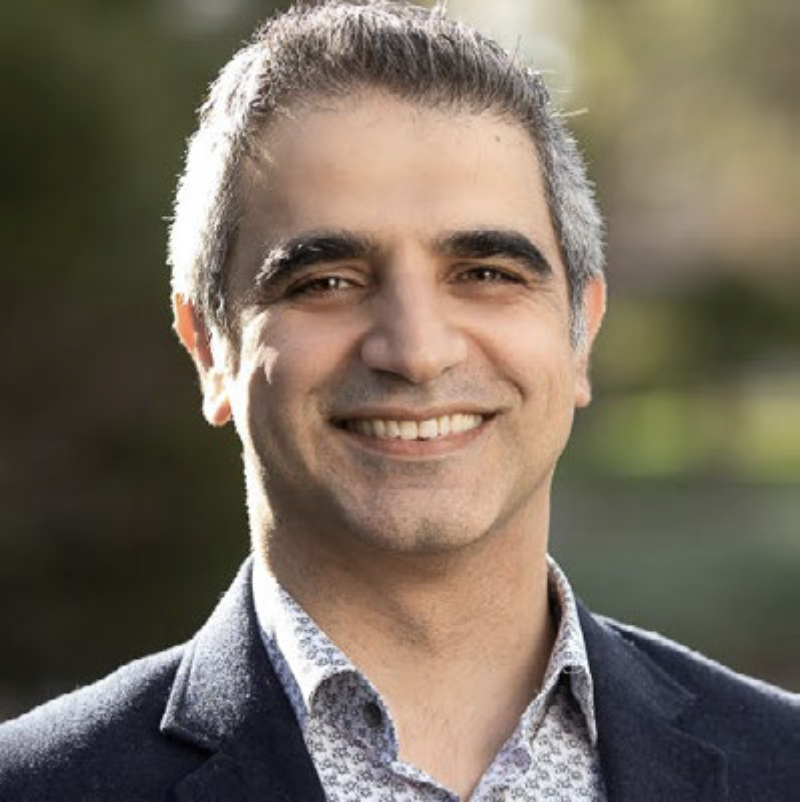
Stories

Reza Sharif-Naeini: The Quest to End Chronic Nerve Pain
When Reza Sharif-Naeini was in high school, his dad had an inexplicable pain in his heel. Many doctors tried and failed to identify the cause of the pain. Frustrated, his dad visited a woman who prayed over the foot by candlelight. “Do you really believe in this?” Sharif couldn’t help asking his dad after the visit. “No,” his father said. “But at least this way nobody is going to accuse me of not having tried everything.”
The experience left a lasting impression on Sharif. “It was surprising to see that despite all these advances that we had made in medicine and engineering, we still knew so little about pain.” This realization inspired him to dedicate his career to understanding the complex interplay of pain responses, a journey that has yielded ground-breaking results, including the discovery of specific neurons involved in the sensation of pain.
Sharif’s interest in scientific research was sparked in college at the University of Montreal. He majored in biochemistry, and, inspired by two of his neuroscience professors, he took a summer internship in a laboratory that investigates the mechanisms of opioid tolerance. “It was so much fun,” he says. “I couldn’t believe that you can actually get paid to do this.”
As an introvert, Sharif found that the quieter, reflective nature of scientific research suited him well. But more than that, it was the pursuit of knowledge that captured his imagination. “Pushing the boundaries of what we know—without needing to be in the spotlight—has always matched my inner drive,” he says.
Sharif’s post-graduate training spanned several related fields, including a master’s degree in psychiatry at McGill University studying pain mechanisms in the spinal cord in the context of arthritis. He began pursuing a doctoral degree doing similar work in a physiology lab, but after just a year, his advisor moved to a new job. “I had to drop everything and find another lab where I could do my Ph.D.,” he says.
This search led him to Charles Bourque, a neuroscientist at McGill whose expertise is in the study of neural responses to mechanical stimuli. Here, Sharif focused on the neuronal sensors involved in our sense of thirst. “It’s a big shift from studying pain mechanisms,” he says, “but this was the lab where I learned the most.” Sharif describes Bourque as the best mentor he’s had—someone who not only shaped his scientific thinking, but also set the standard for how to guide and support young researchers.
With funding from the prestigious Human Frontier Science Program, Sharif began his postdoctoral training under the mentorship of Eric Honoré at the Institute of Molecular and Cellular Pharmacology, in the south of France. He studied mechanosensory defects in people who suffer from autosomal dominant polycystic kidney disease, a condition where there is an accumulation of cysts in the kidneys. In addition to the research, Sharif appreciated the opportunity to immerse himself in a new culture and work with people from diverse backgrounds before heading back to North America. “You come back richer in your experience and knowledge,” he says.
Eager to continue building a diverse skillset, Sharif joined Allan Basbaum at the University of California, San Francisco, whose lab studies pain management from various angles, including genetics and behavior. There, Sharif worked closely with anesthesiologist and pain management specialist, Zhonghui Guan. He recalled seeing Guan treat a patient using a spinal cord stimulation device implanted in the epidural space. “This was somebody who had been in chronic pain for two years, non-stop, eight out of 10 pain—and it stopped suddenly!” he says.
Working with Guan inspired one of Sharif’s main research pursuits. “At first I was going to start my lab and look at mechanosensors,” he says. “But it was so impressive to see how pain relief can work, that a branch of my lab started looking at the circuitry inside the spinal cord that is responsible for the analgesic effect of this simulation.”
In 2012, Sharif returned to his hometown of Montreal to set up his own lab at McGill. The first year was stressful, he says. “The university gives you some startup money, but it wasn’t very much at the time. I was starting to run out of money.” After several attempts, he finally secured funding from the Canada Institute of Health Research to study mechanosensory neurons and their roles in pain. But he was unable to get support for his project on the spinal cord stimulation. “They would say, ‘It’s too ambitious. There’s no way to know that it’s going to work or not, so we’re not going to give you funding for that.’”
About to give up, he decided to give it one more shot and applied for the Rita Allen Foundation Award in Pain. Receiving that funding was “like a life buoy” that enabled him to keep the research going, he says. “It’s like you’re swimming and somebody throws you this, and you manage to catch your breath.”
The award allowed his lab to pursue an investigation into a type of inhibitory neuron in the spinal cord involved in pain signaling. At the time, scientists suspected the electrical pulses delivered through implants to individuals with nerve injury may have worked by switching on these inhibitory neurons, but which cells were involved was unknown. “The question that I started in my lab was what could be the identity of those inhibitory neurons,” he says. “Because if we find them, maybe we can find different ways to turn them on without requiring surgery.” In 2015, the lab’s effort paid off, and they published the discovery in Cell Reports that spinal cord parvalbumin neurons are gatekeepers of neuropathic pain in mice.
In the following years, the Sharif lab continued to advance the field’s understanding of how neurons in the spinal cord affect our sense of touch and pain. In a 2019 Cell Reports paper, they identified the mechanisms that lead to the genetic activation of interneurons involved in nerve pain. Last year, they discovered how parvalbumin neurons modify their firing pattern during chronic pain. This study, published in PNAS, could pave the way for future interventions in pain management.
“It’s been more than 10 years that we have been working on this now,” Sharif says, “and that would have never happened if we hadn’t gotten the Rita Allen funding in the first place.” His team is now looking at ways to turn their discoveries into new treatment approaches. “We would like to be able to find a way to selectively turn on those inhibitor neurons in the spinal cord,” he says.
They’ve begun testing potential molecular switches that they deliver to neurons in lumbar spinal cords donated by deceased patients. “If successful, people would be able to just take a pill when they feel pain, and control the sensation,” Sharif says. “This is the dream.”
Sharif recently offered some advice for early-career researchers and shared what he enjoys doing in his free time:
What would you say to those starting their own lab?
When you first start, you have this long-term vision of where you want to go. But worrying about getting tenure instills a fear in you that forces you to want to play it safe. When you go for small, incremental gains, it makes you forget to take a risk. So I would say, don’t worry about tenure. Focus on the science. Make sure that it’s ambitious. You know, nobody comes and says, I just want to paint this little wall and go home! No, I want to do a big painting!
It’s also important to equip yourself with the right people in the lab, and it’s good to get advice on how to do that from more senior members of the department. Also, have fun! In my lab every two, three years, I have these side projects that I do just for fun, to just feed my curiosity.
What do you do for fun outside of the lab?
Sometimes, once every six months or so, what I do is I tell no one that after I drop my wife and the kids at school in the morning, instead of coming straight to the lab, I go to a spa from 10 in the morning until noon. I come back to the lab at noon, and I’m a new person—and nobody has to know. I guess now everybody will know!